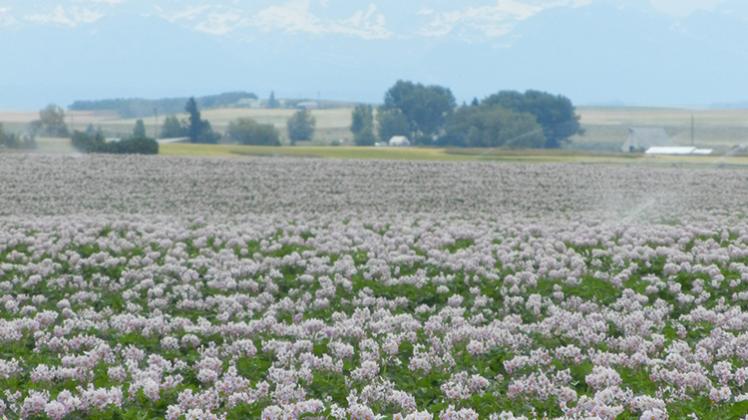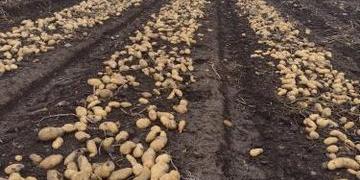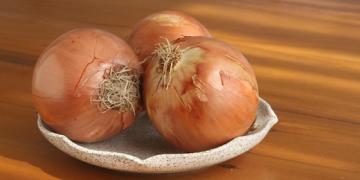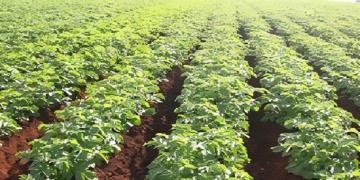EEUU: Adventures in variety selection
Michael Steinmann is a third-generation potato grower on his family farm near Ashton, Idaho, where he grows potatoes for seed.

A few years ago he grew 14 different varieties: red, yellow, brown, white, purple and blue, as well as a few special varieties.
“Many farmers are raising Russet varieties — Burbank, Norkotah, Umatilla and Rangers,” he said. “Different varieties fill a need for certain customers. There are not many people raising the reds and other colors.”
Experience has taught Steinmann, who sells seed potatoes to large companies such as Simplot, to grow certain varieties only if people request them.
“I don’t just try one out of the blue without a definite market,” he said. “I have a pretty big contract for a couple varieties to grow seed potatoes for commercial growers.
“The market for different varieties is expanding, but those markets come and go. There are always new varieties, and they might be popular for a few years and then not. I’ve been stuck with some in the past that I had to haul out and dump.”
For a new variety, a grower can only buy early-generation seed to plant, which is expensive. A commercial grower can’t afford to pay much for seed potatoes.
“If you are growing a new variety, generally it takes two or three years to get enough volume to where you can actually start shipping it out,” Steinmann said. “It takes a while, and there is a lot of expense in propagating those. Often a commercial grower thinks that if you have a certain new variety, you can just supply it to them, but it doesn’t work that way.”
Certain varieties, developed to fit various grower needs, have different purposes, but Steinmann said tried-and- true varieties appeal to the public and thus influence what he grows.
“It’s still hard to beat the old Russet Burbank, however, in terms of a good all-around potato,” Steinmann said. “New varieties have a lot of good qualities in taste and texture, but it’s hard to get the public to try them. They are accustomed to what they’ve always eaten. Most people don’t like change.”
COMMERCIAL SWAY
Doug Parkinson raises seed potatoes near Ellis, Idaho in Custer County, an isolated area where he can grow disease-free seed for his own seed potato operation in southeastern Idaho and for other growers.
“There are more than 300 different varieties of potatoes today, but very few producers grow very many of them,” Parkinson said.
It usually takes five years to get a new variety to a commercial grower, he said.
“Often we’ll get a new variety and bring it forward and by the time it’s ready for the commercial industry, they decide they don’t want it, and then we just have to throw it out,” he said.
“I used to do quite a bit with new varieties, thinking one of them would be a big hit, but never had any success with a new variety until the commercial industry reached out to have me grow it. I’ve lost way too much money trying to guess which variety the commercial growers would want.”
Many new varieties released don’t make it on a large scale, Parkinson said, though he concurred with Steinmann on the enduring popularity of one potato type.
“Some people think the Russet Burbank will be replaced and go away, but it still makes up half of all potatoes grown,” he said. “It’s still the old dependable one.”
There are new varieties that are more resistant to common potato pests and diseases, but these genetically engineered potatoes are not as popular with the public, Parkinson said.
“I don’t understand why people don’t want GMO potatoes. Corn today is 90% GMO and corn is in practically every processed food, High-fructose corn syrup is everywhere,” he said. “If we can breed plants to be immune or resistant to late blight and some of the other pests, why not use them?”
Parkinson noted that newer varieties can be bred without acrylamide, a chemical that forms in starchy foods when they are cooked at high temperatures and classified as likely to be carcinogenic to humans by the EPA. The reaction of sugars and the amino acid asparagine causes food to brown.
“I don’t know why GMO isn’t a huge plus for the potato industry, because these new varieties don’t need as many pesticides and chemicals to grow,” Parkinson said.
SPUD-SPECIFIC CONSIDERATIONS
New varieties can find a place because they can fit various needs. For example, Ranger Russet’s long shape makes them ideal for french frying.
“Some varieties grow better in warmer climates. The Russet Burbank doesn’t do well in heat and this is why Idaho has been great for this one, with our cooler climate,” Parkinson said. “Norkotahs are beautiful, even though they don’t taste as good as a Burbank.”
Norkotahs can also pack out at 90% No. 1, a USDA grade that means they have similar varietal characteristics including shape and cleanliness. That makes them a better marketing choice for fresh marketers, though they can also be more susceptible to Potato Virus Y, which affects yield, Parkinson said.
“Everything comes with pros and cons,” he said.
Certain varieties, developed to fit various grower needs, have different purposes, but Steinmann said tried-and-true varieties, such as the Russet Burbank, appeal to the public and thus influence what he grows. Photo courtesy of Michael Steinmann.Parkinson said he currently only raises Russet Burbanks, Rangers and three Norkotah varieties, along with Teton Russets, a new variety from the Tri-State Potato Research and Breeding Program that stores and yields well, he said.
“Storability for a seed potato grower is important, because sometimes we have to hold our potatoes for seven months before we ship them,” Parkinson said.
The Tri-State program is a cooperative regional collaboration of USDA Agricultural Research Service, Oregon State University, University of Idaho, Washington State University and the potato commissions of the three states.
For a potato seed grower, it takes a lot of foundational work to gear up to sell a new variety.
“We start with 1,500 plants in the greenhouse, and by the end of the first year in the field, we’ll have 200 to 250 hundredweight of seed,” Parkinson said. “By the end of the second year we can have 2,000 hundredweight. These are in small lots, so it’s very labor-intensive.
“You can’t do very many of these or it takes the profit out of your operation. You need a guaranteed market for the end result after you put in all that time and money.”
Fuente: spudman.com




